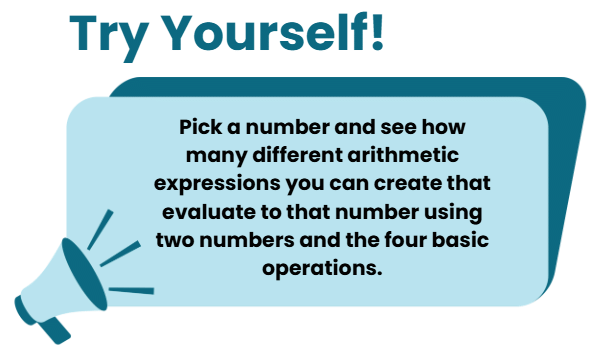Arithmetic Expressions Class 7 Notes Maths Chapter 2 Free PDF
| Table of contents |

|
| Introduction |

|
| Simple Expressions |

|
| Reading and Evaluating Complex Expressions |

|
| Solved Examples |

|
Introduction
Phrases like "13 + 2" (13 plus 2), "20 – 4" (20 minus 4), or "12 × 5" (12 times 5) are common in mathematics. These combinations are called arithmetic expressions.
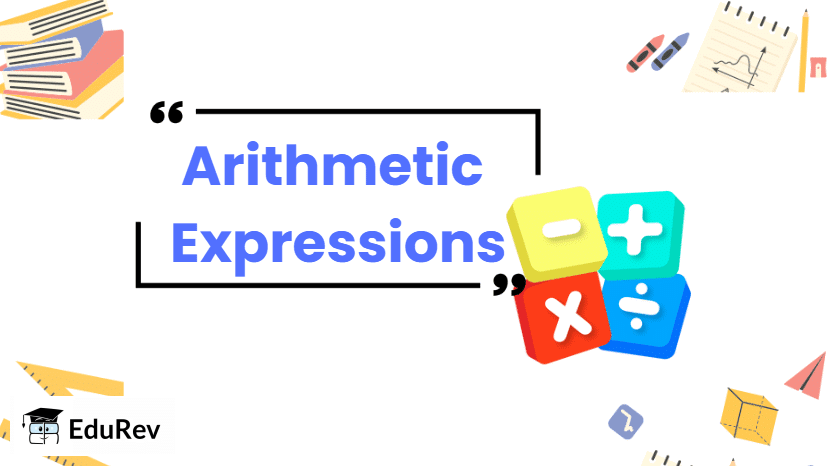
Simple Expressions
- Every arithmetic expression has a specific value, which is the single number it represents. For instance, the expression "13 + 2" has a value of 15.
- We use the equals sign (=) to show this relationship: 13 + 2 = 15.
- Think about Mallika spending ₹25 each weekday (Monday to Friday) for lunch. To find her total weekly spending, we can write the expression 5 × 25. This expression represents "5 times 25," and its value tells us the total amount spent.
10 + 2 = 1215 – 3 = 123 × 4 = 1224 ÷ 2 = 12
This flexibility allows us to express the same mathematical idea in multiple ways, which can be useful in different contexts or for simplifying problems.
Comparing Expressions
10 + 2 and 7 + 1:- The value of
10 + 2is12. - The value of
7 + 1is8. - Since 12 is greater than 8, we can write:
10 + 2 > 7 + 1.
13 – 2 and 4 × 3:- The value of
13 – 2is11. - The value of
4 × 3is12. - Since 11 is less than 12, we write:
13 – 2 < 4 × 3.
Reading and Evaluating Complex Expressions
30 + 5 × 4? Without a clear context or rule, how do we know whether to add first or multiply first? This ambiguity can lead to different answers.
- Sentence (a): "Shalini sat next to a friend with toys". (Meaning: The friend has toys, Shalini sat next to her).

- Sentence (b): "Shalini sat next to a friend, with toys". (Meaning: Shalini has the toys, and she sat next to her friend).

Similarly, in mathematics, we need rules and tools to ensure everyone evaluates a complex expression the same way.
30 + 5 × 4.- Purna's calculation: Added 30 and 5 first (30 + 5 = 35), then multiplied by 4 (35 × 4 = 140).
- Mallesh's calculation: Multiplied 5 and 4 first (5 × 4 = 20), then added 30 (30 + 20 = 50).
⇒ This highlights that just looking at the expression
30 + 5 × 4 isn't enough; we need a standard order of operations.Brackets in Expressions
- One of the primary tools used in mathematics to clarify the order of operations in complex expressions is brackets ( ).
- When an expression contains brackets, the part of the expression inside the brackets must be evaluated first, before performing operations outside the brackets.
30 + 5 × 4. We determined that multiplication should happen before addition based on the context. We can make this explicit using brackets:
30 + (5 × 4)- First, calculate the value inside the brackets:
5 × 4 = 20. - Then, perform the remaining operation:
30 + 20 = 50.
Ans: Irfan spent ₹15 on a biscuit packet and ₹56 on toor dal.
So, the total cost in rupees is 15 + 56.
He gave ₹100 to the shopkeeper. So, he should get back 100 minus the total cost.
Can we write that expression as— 100 – 15 + 56 ?
Can we first subtract 15 from 100 and then add 56 to the result?
We will get 141.
It is absurd that he gets more money than he paid the shopkeeper!
We can use brackets in this case:
100 – (15 + 56).
Evaluating the expression within the brackets first, we get 100 minus 71, which is 29.
So, Irfan will get back ₹29.
Example 2: Rani went to a stationery shop. She bought a notebook for ₹40 and a pen for ₹25. She gave the shopkeeper ₹100. How much money will she get back?
Step 1: Total cost of the items
₹40 + ₹25 = ₹65
Step 2: Amount given to the shopkeeper
₹100
Step 3: Expression to find the balance
100 – (40 + 25)
Step 4: Solve using brackets
= 100 – 65
= ₹35
Ans: Rani will get back ₹35.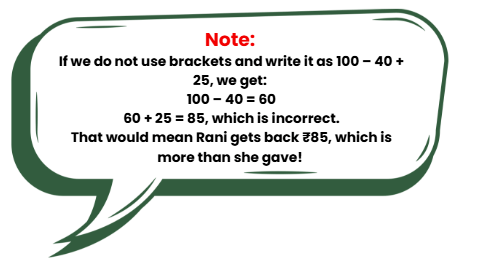
Terms in Expressions
30 + 5 × 4? While brackets are one way to clarify order, another fundamental concept used is that of terms.Terms are the parts of an expression separated by addition (+) signs.
- Expression:
12 + 7- Already in addition form.
- Terms:
12and7. - Marked:
12 + 7
- Expression:
83 – 14- Convert subtraction:
83 + (–14) - Terms:
83and–14. - Marked:
83 + (–14)
- Convert subtraction:
- Expression:
–18 – 3- Convert subtraction:
–18 + (–3) - Terms:
–18and–3. - Marked:
–18 + (–3)
- Convert subtraction:
- Expression:
6 × 5 + 3- Already in addition form.
- Notice that
6 × 5does not contain an addition sign separating the 6 and 5. It represents a single value obtained through multiplication. - Terms:
6 × 5and3. - Marked:
(6 × 5) + 3
- Expression:
2 – 10 + 4 × 6- Convert subtraction:
2 + (–10) + 4 × 6 - Terms:
2,–10, and4 × 6. - Marked:
2 + (–10) + (4 × 6)
- Convert subtraction:
Identifying terms is crucial for the standard order of operations:
1. Evaluate each term first: Perform all multiplications and divisions within each term.
2. Add the resulting values of the terms: Once each term has been simplified to a single number, perform the additions (including the additions that came from converted subtractions).
30 + 5 × 4 using terms:- Identify terms:
30and5 × 4. - Evaluate each term: The term
30is already evaluated. The term5 × 4evaluates to20. - Add the term values:
30 + 20 = 50.
Swapping and Grouping
Let's investigate.
6 – 4. Converting to addition gives 6 + (–4).- The terms are
6and–4. - The value is
6 + (–4) = 2.
–4 + 6.- The value is
–4 + 6 = 2.
Swapping any two terms in an addition expression does not change the final value.

This property is formally known as the Commutative Property of Addition.
(–7) + 10 + (–11).- Group the first two terms:
( (–7) + 10 ) + (–11)= ( 3 ) + (–11)= –8
- Group the last two terms:
(–7) + ( 10 + (–11) )= (–7) + ( –1 )= –8

This property is formally known as the Associative Property of Addition.
Conclusion: Order Doesn't Matter for Addition
Because of the commutative and associative properties, when an expression only involves addition (after converting subtractions), we can add the terms in any order or grouping we find convenient, and the result will always be the same.For example, in(–7) + 10 + (–11), we could add the negative terms first:(–7) + (–11) = –18, and then add the positive term:–18 + 10 = –8.
In mathematics we use the phrase commutative property of addition instead of saying “swapping terms does not change the sum”. Similarly, “grouping does not change the sum” is called the associative property of addition.
Swapping the Order of Things in Everyday Life
Manasa’s mom says:
“Wear your hat and shoes.”
Manasa can do either:
Wear her hat first, then her shoes, or

Wear her shoes first, then her hat.

Result:
Manasa will still be ready to go out and look the same either way.
➡ Here, the order does not matter.
In math, this is like:
2 + 3 = 5 and 3 + 2 = 5
Addition can be done in any order — it won’t change the answer
Order
Does
Matter
Now her mom says:
“Wear your socks and shoes.”
This time:
If Manasa wears socks first, then shoes — ✅ that’s the correct way.
But if she wears shoes first, then tries to wear socks — ❌ it's wrong and uncomfortable!
Result:
She’ll look odd and it won’t work properly.
➡ Here, the order matters.
In math, this is like:
8 – 5 = 3, but 5 – 8 = -3
So in subtraction, changing the order changes the answer.
More Expressions and Their Terms
- Situation: 4 friends order 4 dosas at ₹23 each and want to leave a ₹5 tip.
- Expression for total cost: The cost of the dosas is
4 × 23. The tip is5. The total cost is the sum:4 × 23 + 5.
- Identifying Terms: The expression is already a sum. The terms are
4 × 23and5. - Evaluation:
- Evaluate terms:
4 × 23 = 92. The term5is already evaluated. - Add term values:
92 + 5 = 97.
- Evaluate terms:
- Total Cost: ₹97.
- Situation: 33 students are playing. The teacher calls out '5'. Students form groups of 5. Ruby observes.
- Observation: Ruby sees 6 full groups of 5, with 3 students left over.
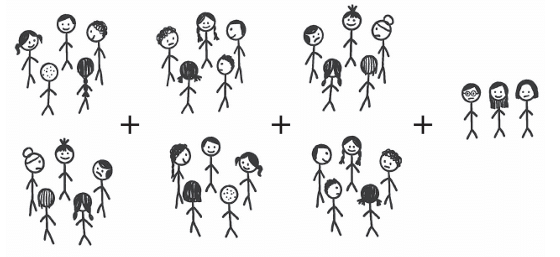
- Expression: Ruby writes
6 × 5 + 3(representing 6 groups of 5, plus the 3 remaining). - Identifying Terms: The terms are
6 × 5and3. - Evaluation:
(6 × 5) + 3 = 30 + 3 = 33(the total number of students playing). - Variations:
- If the teacher called '4': There would be 8 groups of 4 with 1 left over. Expression:
8 × 4 + 1. Terms:8 × 4and1. - If the teacher called '7': There would be 4 groups of 7 with 5 left over. Expression:
4 × 7 + 5. Terms:4 × 7and5.
- If the teacher called '4': There would be 8 groups of 4 with 1 left over. Expression:
- Situation: Raghu buys 100 kg rice, packs it into 2 kg bags. He already had 4 such bags.
- Expression for total bags: Number of new bags =
100 ÷ 2(or100/2). Total bags =4 + 100 ÷ 2. - Identifying Terms: The terms are
4and100 ÷ 2.
- Evaluation:
- Evaluate terms:
4is evaluated.100 ÷ 2 = 50. - Add term values:
4 + 50 = 54.
- Evaluate terms:
- Total Bags: 54 bags.
- Situation: Paying ₹432 using various denominations.
- Possibility 1 Expression:
4 × 100 + 1 × 20 + 1 × 10 + 2 × 1- Terms:
4 × 100,1 × 20,1 × 10,2 × 1. - Evaluation:
400 + 20 + 10 + 2 = 432.
- Terms:
- Possibility 2 Expression:
8 × 50 + 1 × 10 + 4 × 5 + 2 × 1- Terms:
8 × 50,1 × 10,4 × 5,2 × 1. - Evaluation:
400 + 10 + 20 + 2 = 432.
- Terms:
- This shows how expressions can represent real-world combinations, and identifying terms helps understand the structure.
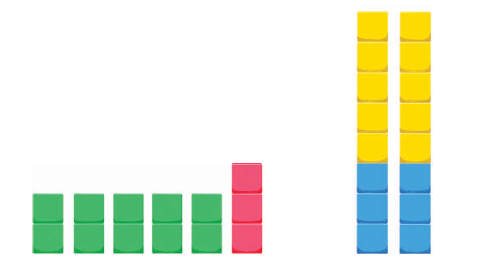 Which image is correct?
Which image is correct?
- Expression:
5 × 2 + 3 - Identifying Terms:
5 × 2and3. - Evaluation:

- Interpretation: The expression means "3 more than 5 groups of 2". This matches the picture showing 5 pairs of items plus 3 individual items.
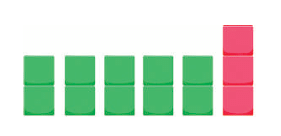 This Image is correct
This Image is correct
Removing Brackets — I
Let us find the value of this expression,
200 – (40 + 3).
We first evaluate the expression inside the bracket to 43 and then subtract it from 200. But it is simpler to first subtract 40 from 200:
200 – 40 = 160.
And then subtract 3 from 160:
160 – 3 = 157.
What we did here was 200 – 40 – 3. Notice, that we did not do
200 – 40 + 3.
So,
200 – (40 + 3) = 200 – 40 – 3.
Removing Brackets - II
Example: Lhamo and Norbu went to a hotel. Each of them ordered a vegetable cutlet and a rasgulla. A vegetable cutlet costs ₹43 and a rasgulla costs ₹24. Write an expression for the amount they will have to pay.
Situation:
Lhamo and Norbu each buy:
1 vegetable cutlet = ₹43
1 rasgulla = ₹24
So, the amount one person pays is:
43 + 24
There are two people, so together they pay:
(43 + 24) + (43 + 24)
Instead of writing it this way, we can simplify using brackets and multiplication:
2 × (43 + 24)
Why use brackets?
Brackets tell us to first add the items, and then multiply the total by 2 (for two people).
So,
2 × (43 + 24) = 2 × 67 = ₹134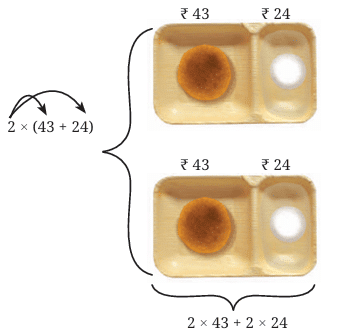
This is much simpler than adding 43 + 24 twice!
What if another friend, Sangmu joins?
If a third person, Sangmu, joins and buys the same items, then the expression becomes:
3 × (43 + 24)
That means: 3 × 67 = ₹201
Example: In the Republic Day parade, there are boy scouts and girl guides marching together. The scouts march in 4 rows with 5 scouts in each row. The guides march in 3 rows with 5 guides in each row (see the figure below). How many scouts and guides are marching in this parade?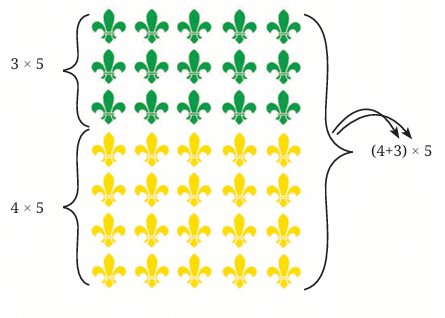
Boy scouts: 4 rows × 5 boys = 20
Girl guides: 3 rows × 5 girls = 15
So total people = 20 + 15 = 35
But we can do this smarter:
Instead of calculating separately, first add the rows:
(4 + 3) × 5
Computing these expressions, we get
(4 + 3) × 5 = 7 × 5 = 35
What’s the lesson here?
Using brackets helps us to group numbers and make multiplication or subtraction easier.
For example:
Distributive Property:
(a + b) × c = a × c + b × c
(a – b) × c = a × c – b × c
Example:
(10 + 3) × 98 = 10 × 98 + 3 × 98 = 13 × 98
This makes solving faster and more organized.
The multiple of a sum (or difference) = sum (or difference) of the multiples.
Solved Examples
30 + 5 × 4Expression:
Identify Terms: The terms are30 + 5 × 430and5 × 4.
Evaluate Terms:
30is already evaluated.5 × 4 = 20.Add Term Values:
30 + 20 = 50.
Answer: 50
100 – (15 + 56)Expression:
100 – (15 + 56)Evaluate Inside Brackets First:
15 + 56 = 71.Perform Remaining Operation:
100 – 71 = 29.Answer: 29
4 × 23 + 5Expression:
4 × 23 + 5Identify Terms:
4 × 23and5.Evaluate Terms:
4 × 23 = 92.5is already evaluated.Add Term Values:
92 + 5 = 97.Answer: 97
FAQs on Arithmetic Expressions Class 7 Notes Maths Chapter 2 Free PDF
| 1. What are simple expressions in math? |  |
| 2. How do you evaluate complex expressions? |  |
| 3. Can you give an example of a complex expression and how to evaluate it? |  |
| 4. What are the key takeaways from learning arithmetic expressions? |  |
| 5. Why are arithmetic expressions important in math? |  |

